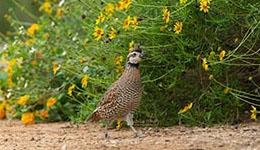
Northern bobwhite quail (Colinus virginianus) are considered a premier game bird by many, and many people enjoy hearing the familiar bobwhite whistle in the late spring and early summer. However, over the past 30 to 40 years populations have dropped by more than 70% to historically low levels.
The population decline can be attributed to many causes, but the most important reason has been a significant loss of high-quality habitat. There is a direct cause and effect relationship between changes in land use and this population decline.
Quality bobwhite quail habitat consists of diverse early-successional vegetation that includes a balanced mixture of annual forbs and weeds, legumes, native warm-season grasses and clumps of shrubby vegetation (often referred to as "covey headquarters"). These types of vegetation provide the cover necessary for nesting, brood-rearing and escaping predators as well as seeds and insects that are important food items. Refer to MU Extension publication MP907, Establishing and Managing Early Successional Habitats for Wildlife on Agricultural Lands for management techniques that promote habitats beneficial to bobwhites.
Bobwhite quail populations can be successfully managed and the number of coveys increased on your property if you take appropriate action to provide habitats for the species to use throughout the year. In addition, many of these practices can be implemented to improve habitats for cottontail rabbits, mourning doves and wild turkey within Missouri's agricultural and forested landscapes.

Read MU Extension bobwhite quail guides
Find resources for counting quail, ecology, quail-friendly plants and more.